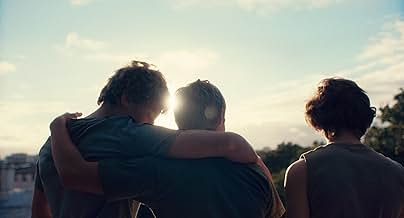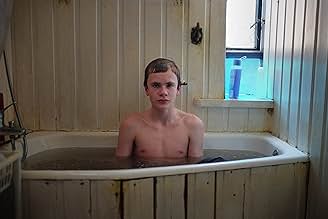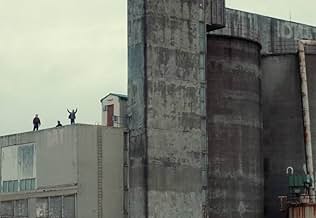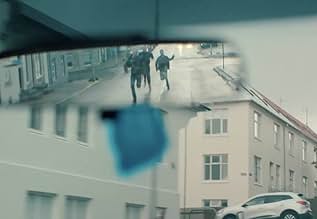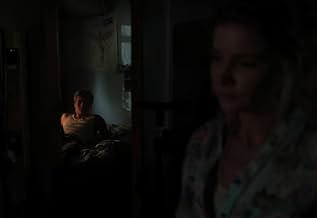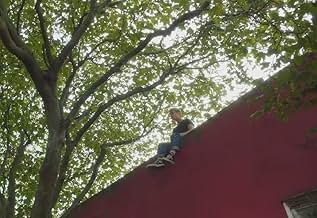NOTE IMDb
7,3/10
2,9 k
MA NOTE
Ajouter une intrigue dans votre langueAddi, a gifted boy raised by a clairvoyant mother, decides to adopt a bullied misfit into his gang of outsiders. Left to their own devices, the boys discover aggression, violence, loyalty, a... Tout lireAddi, a gifted boy raised by a clairvoyant mother, decides to adopt a bullied misfit into his gang of outsiders. Left to their own devices, the boys discover aggression, violence, loyalty, and love.Addi, a gifted boy raised by a clairvoyant mother, decides to adopt a bullied misfit into his gang of outsiders. Left to their own devices, the boys discover aggression, violence, loyalty, and love.
- Réalisation
- Scénario
- Casting principal
- Récompenses
- 9 victoires et 25 nominations au total
Aníta Briem
- Guðrún (Addi's mother)
- (as Anita Briem)
Þórhildur Ingunn
- Elísa (Addi's sister)
- (as Þórhildur Ingunn Pétursdóttir)
Avis à la une
Baldur has the look that abused kids often have - especially the gentle ones. Totally closed in on himself, hang-dog, afraid to look anyone in the eye. Trying to shrink, trying to go invisible. We are not surprised to see him bullied: his manner is so fearful of attack that he invites it.
We are surprised, however, at how violent the bullying gets when one his classmates smashes him across the face with a wooden post. Suffering a broken nose and fractured skull, Baldur then has to wear a white mask to school, like a bad guy in a pantomime, and this only marginalises him further.
When Baldur's situation and demeanour again attracts unwanted attention from other youths, we expect yet more bullying and at first, we get it. Siggi, Konni and Addi invite themselves into Baldur's life, heedless of his obvious wish to be left alone. They barge their way into his house, and when Konni kicks a hole in the wall, freak out a little bit about what "Balli"'s mother might say. It turns out she doesn't really care, because she's barely around anyway, and the house is squalid and most of the walls and doors are already damaged by Balli's violent stepfather, who also shot out one of the teenager's eyes when he was four, with a BB-gun the stepfather wanted to "find out of it was loaded".
The boys then actually clean Balli's house, and he is more or less a member of their gang of drug-using, vandalising, oft-violent misfits. The other two would have been content with just victimising Baldur, but you see, Addi too has a stepfather, and he knows what it's like.
We know this group is heading for trouble and even greater violence. At first, we empathise only with Baldur, the least-violent and least-trouble causing. The gang seems indistinguishable from the kids that attacked him previously. However we come to know and care for them, especially Addi.
The movie is beautifully shot, which contrasts with the ugly behaviour of its characters. The music is also beautiful at times. Many might find its characters repellent, and it was hard for me to take a lot of the time, but by the time we meet Baldur's stepfather, and realise the connection Baldur and Addi both share, we understand why they are the way they are, and we totally understand why they feel their story needs to take the violent turn it does.
These "beautiful beings" were left behind. They apparently have very little supervision at school - I don't remember any teachers in any of the school scenes - and their parents are absent, either off on drug/alcohol benders or throwing themselves into mysticism like tarot cards when the problems their kids have are urgent and absolutely real.
Young men take what options they have open to them: here they felt there was only one option.
After "Heartstone", I was very interested to see what Guðmundur Arnar Guðmundsson was going to do next. With "Beautiful Beings", an aching, beautiful small-time masterpiece, he's outdone himself.
Lastly, the performance of Áskell Einar Pálmason in the movie as Baldur/Balli is a masterwork. He is so utterly believable the movie could be a documentary about his life. It's so real that our hearts break, not only for the Balli on the screen, but all the kids in similar situations wherever on earth you find people.
We are surprised, however, at how violent the bullying gets when one his classmates smashes him across the face with a wooden post. Suffering a broken nose and fractured skull, Baldur then has to wear a white mask to school, like a bad guy in a pantomime, and this only marginalises him further.
When Baldur's situation and demeanour again attracts unwanted attention from other youths, we expect yet more bullying and at first, we get it. Siggi, Konni and Addi invite themselves into Baldur's life, heedless of his obvious wish to be left alone. They barge their way into his house, and when Konni kicks a hole in the wall, freak out a little bit about what "Balli"'s mother might say. It turns out she doesn't really care, because she's barely around anyway, and the house is squalid and most of the walls and doors are already damaged by Balli's violent stepfather, who also shot out one of the teenager's eyes when he was four, with a BB-gun the stepfather wanted to "find out of it was loaded".
The boys then actually clean Balli's house, and he is more or less a member of their gang of drug-using, vandalising, oft-violent misfits. The other two would have been content with just victimising Baldur, but you see, Addi too has a stepfather, and he knows what it's like.
We know this group is heading for trouble and even greater violence. At first, we empathise only with Baldur, the least-violent and least-trouble causing. The gang seems indistinguishable from the kids that attacked him previously. However we come to know and care for them, especially Addi.
The movie is beautifully shot, which contrasts with the ugly behaviour of its characters. The music is also beautiful at times. Many might find its characters repellent, and it was hard for me to take a lot of the time, but by the time we meet Baldur's stepfather, and realise the connection Baldur and Addi both share, we understand why they are the way they are, and we totally understand why they feel their story needs to take the violent turn it does.
These "beautiful beings" were left behind. They apparently have very little supervision at school - I don't remember any teachers in any of the school scenes - and their parents are absent, either off on drug/alcohol benders or throwing themselves into mysticism like tarot cards when the problems their kids have are urgent and absolutely real.
Young men take what options they have open to them: here they felt there was only one option.
After "Heartstone", I was very interested to see what Guðmundur Arnar Guðmundsson was going to do next. With "Beautiful Beings", an aching, beautiful small-time masterpiece, he's outdone himself.
Lastly, the performance of Áskell Einar Pálmason in the movie as Baldur/Balli is a masterwork. He is so utterly believable the movie could be a documentary about his life. It's so real that our hearts break, not only for the Balli on the screen, but all the kids in similar situations wherever on earth you find people.
The young cast was incredible in this. There were a lot of nuance to their acting, and they brought a lot of depth to their characters. This isn't an easy topic to tackle, and to be able to potray something so raw and real at such a young age really shows how talanted the actors are in this. The story is both beautiful and heartbreaking. I understand the ending, but damn, if I didn't wish for it not to end like that. I guess that's where my disappointment comes in. I understand and respect the ending, but it was also predictable and I just wanted more for the characters, but life doesn't always unfold the way we want. I absolutley loved the first half, the second half became a bit to repetitive, and too brutal for my liking which combined with ending made me wishing for more. I don't know, it felt like there was more to the story than where, and how, it ended.
A captivating, often brutal dip into the lives of four 14-year-old boys in roughly 2000-era Iceland. Addi, the one with a conscience, takes badly bullied Balli into his group of friends after feeling a twinge of compassion at seeing him being mistreated. The acting from the four first-time protagonists is exceptional. Award-worthy. I can easily see them being named joint best actors at festivals (I saw it twice in Berlin).
Áskell Einar Pálmason as Balli delivers an understated masterclass in nervous glances, twitches and despair. It's all the more impressive to see how, as the character eases into life with his first friends, his body language changes, almost imperceptibly.
Birgir Dagur Bjarkason may well take the plaudits with his turn as Addi, he carries the film on his young shoulders and doesn't put a foot wrong, whether joining in the violence or experiencing the dreamlike (often nightmarish) visions that give the film its Icelandic name.
Snorri Rafn Frímannsson has less to do as Siggi than the others but has charisma and backs the others up as his character does on screen.
But for me it is Viktor Benóný Benediktsson, as Konni, who delivers the star turn. A thug known as The Animal, his Konni is able to deliver the aggression needed to make his character believable, punching and swinging wildly through the film in an often terrifying manner. But one by one the layers are stripped away to reveal - not that he would admit it - the scared boy trapped in the young man's body. Such a broad performance would test actors twice his age but he aces it. They all do.
A note on the fight scenes, which through a combination of beautiful camera work and expert, almost balletic choreography come across as some of the most realistic I can remember. This isn't filmic violence, these are kids kicking lumps out of each other. Harsh, cold, real, shocking.
One criticism comes in the pacing at the end and an inclusion of possibly too many story strands that don't really have chance to justify their place in the final film. It feels a bit like a 2h30 film that a producer has demanded becomes 2hrs. If that's the case I hope a director's cut will follow - I would gladly spend all day in the company of the fascinating characters that director Guðmundur Arnar Guðmundsson has so expertly and lovingly brought to the screen.
Áskell Einar Pálmason as Balli delivers an understated masterclass in nervous glances, twitches and despair. It's all the more impressive to see how, as the character eases into life with his first friends, his body language changes, almost imperceptibly.
Birgir Dagur Bjarkason may well take the plaudits with his turn as Addi, he carries the film on his young shoulders and doesn't put a foot wrong, whether joining in the violence or experiencing the dreamlike (often nightmarish) visions that give the film its Icelandic name.
Snorri Rafn Frímannsson has less to do as Siggi than the others but has charisma and backs the others up as his character does on screen.
But for me it is Viktor Benóný Benediktsson, as Konni, who delivers the star turn. A thug known as The Animal, his Konni is able to deliver the aggression needed to make his character believable, punching and swinging wildly through the film in an often terrifying manner. But one by one the layers are stripped away to reveal - not that he would admit it - the scared boy trapped in the young man's body. Such a broad performance would test actors twice his age but he aces it. They all do.
A note on the fight scenes, which through a combination of beautiful camera work and expert, almost balletic choreography come across as some of the most realistic I can remember. This isn't filmic violence, these are kids kicking lumps out of each other. Harsh, cold, real, shocking.
One criticism comes in the pacing at the end and an inclusion of possibly too many story strands that don't really have chance to justify their place in the final film. It feels a bit like a 2h30 film that a producer has demanded becomes 2hrs. If that's the case I hope a director's cut will follow - I would gladly spend all day in the company of the fascinating characters that director Guðmundur Arnar Guðmundsson has so expertly and lovingly brought to the screen.
Beautiful Beings is a masterfully told story of the struggles of being a teen in an imperfect world full of imperfect families and imperfect situations. It is a raw and yet at times heart warming look in to the lives of four teen boys navigating a train wreck of circumstances. Its dark plot is skillfully developed with subtle misdirection and haunting foreshadowing. The clever pacing captures the intensity and destructiveness of these damaged lives all while offering reprieves of humor and cathartic tenderness.
At the root of it the story has been told countless times. An outsider is brought into a circle of friends, harsh teen cruelties and outright disdain slowly melt into new dynamics and personal growth. It is The Breakfast Club but with a much more unpretentious group of troubled youth. A sort of Stranger Things but with very non-paranormal dangers. And with the highest praise one could say it is retelling this narrative with the honesty and insight of films like The Perks of Being a Wallflower or the original Let the Right Ones In. This film triumphs in is brutal honesty and is mesmerizing in its depiction of life in a weathered blue-collar Reykjavík suburb. Its characters and dialogue hit masterfully again and again with very uniquely Icelandic circumstances and yet it remains universal in its observation of struggling families.
Part of what I love most about what writer-Director Guðmundur Arnar Guðmundsson has done so well with this film is its wonderful casting. The characters are so awkwardly enjoyable to discover. And very careful consideration to the physical size of the characters helps build the narrative. The smallest are the most vulnerable the largest the most menacing. And the performances he has inspired from everyone, in particularly the young leads, is truly award worthy. These actors deliver strong consistently motivated characters who you quickly fell you have known for a lifetime. Each actor clearly understood the purpose of their character and delivers the needed dynamics with a clarity one would expect from a fly on the wall documentary.
There is one one particularly refreshing aspect of the modern teen depicted in this film that I don't think I have seen done so well before. These teens, with all their troubles (and boy do they have troubles) have grown up in a world that is starting to address toxic masculinity. They really struggle with catching themselves being outright jerks. Being teens that make impulsive choices with little thought of how profoundly their actions could impact those around them or being drawn to responding to insult with escalations of violence. All this is happening while they also trying to influence better of themselves and their piers. And by shining a light on their own actions, by coming to the defense of those who are being shamed for exposing personal vulnerabilities or with unexpected selfless actions they enable changes. Now to be clear these teens are still brutally crude, and groose, quick to anger and cruel but they've grown up at least in a system that has taught them to question this. It's characters in this kind of shifting world that I haven't seen depicted before so thoughtfully.
Beautiful Beings continues the growing trend of more honest and therefore often darker looks into the coming of age narrative. It needs to be said this film depicts and addresses social poverty, teen cruelty, violence, self harm, teen sexuality, mental illness, drug use and even rape with brutal honesty. And it is a more perfect movie having depicted these realities honestly. It is a wonderfully crafted, hauntingly acted modern look at teens struggling in a brutally imperfect world to discover for the first time or retain what makes them Beautiful Beings.
At the root of it the story has been told countless times. An outsider is brought into a circle of friends, harsh teen cruelties and outright disdain slowly melt into new dynamics and personal growth. It is The Breakfast Club but with a much more unpretentious group of troubled youth. A sort of Stranger Things but with very non-paranormal dangers. And with the highest praise one could say it is retelling this narrative with the honesty and insight of films like The Perks of Being a Wallflower or the original Let the Right Ones In. This film triumphs in is brutal honesty and is mesmerizing in its depiction of life in a weathered blue-collar Reykjavík suburb. Its characters and dialogue hit masterfully again and again with very uniquely Icelandic circumstances and yet it remains universal in its observation of struggling families.
Part of what I love most about what writer-Director Guðmundur Arnar Guðmundsson has done so well with this film is its wonderful casting. The characters are so awkwardly enjoyable to discover. And very careful consideration to the physical size of the characters helps build the narrative. The smallest are the most vulnerable the largest the most menacing. And the performances he has inspired from everyone, in particularly the young leads, is truly award worthy. These actors deliver strong consistently motivated characters who you quickly fell you have known for a lifetime. Each actor clearly understood the purpose of their character and delivers the needed dynamics with a clarity one would expect from a fly on the wall documentary.
There is one one particularly refreshing aspect of the modern teen depicted in this film that I don't think I have seen done so well before. These teens, with all their troubles (and boy do they have troubles) have grown up in a world that is starting to address toxic masculinity. They really struggle with catching themselves being outright jerks. Being teens that make impulsive choices with little thought of how profoundly their actions could impact those around them or being drawn to responding to insult with escalations of violence. All this is happening while they also trying to influence better of themselves and their piers. And by shining a light on their own actions, by coming to the defense of those who are being shamed for exposing personal vulnerabilities or with unexpected selfless actions they enable changes. Now to be clear these teens are still brutally crude, and groose, quick to anger and cruel but they've grown up at least in a system that has taught them to question this. It's characters in this kind of shifting world that I haven't seen depicted before so thoughtfully.
Beautiful Beings continues the growing trend of more honest and therefore often darker looks into the coming of age narrative. It needs to be said this film depicts and addresses social poverty, teen cruelty, violence, self harm, teen sexuality, mental illness, drug use and even rape with brutal honesty. And it is a more perfect movie having depicted these realities honestly. It is a wonderfully crafted, hauntingly acted modern look at teens struggling in a brutally imperfect world to discover for the first time or retain what makes them Beautiful Beings.
Guðmundur Arnar Guðmundsson film from 2022.
Many artists and writers present to us the pain of adolescence, the effects of which they still cannot get rid of in their works. This is one of the most important sources that literature and art have been fed since their existence.
Guðmundsson, born in 1982, I think, has conveyed the pain of adolescence to the audience in a unique and disturbing reality, like a fist in the stomach, as in the films Ártún (2014) / Hjartasteinn (2016).
Guðmundsson's 'storytelling' skill that goes beyond scriptwriting, and the ability to deliver the resulting work to adolescent actors whom no one has given / known before, and always getting good results as a result of this risk, I think, stems from his ability to explain himself to his actors.
Berdreymi, who made its second screening in the world at the Istanbul Film Festival, is once again a Guðmundsson classic and easily stands out from the 2022 films with the closed nature of Iceland and its character reflecting it.
Our character Baldur (Hjartasteinn's young actor's name is a nice detail) was a father figure to all of his friends when he was a wounded child, but he never left his childhood, all the child actors hurt the audience's hearts with their characters, Kristian Eidnes Andersen's great compositions and with camera moves that take the movie to another dimension Thanks to Sturla Brandth Grøvlen, Guðmundsson has outdone herself in her art.
Just as he discovered Baldur Einarsson in the movie Hjartasteinn, he brought Birgir Dagur Bjarkason to the cinema in this movie as well, who will be a great actor with the right direction.
Long story short, Berdreymi is a masterpiece that should be watched not only for those who love northern cinema or 'Coming-Age' movies, but also for anyone who defines himself as a cinephile.
Many artists and writers present to us the pain of adolescence, the effects of which they still cannot get rid of in their works. This is one of the most important sources that literature and art have been fed since their existence.
Guðmundsson, born in 1982, I think, has conveyed the pain of adolescence to the audience in a unique and disturbing reality, like a fist in the stomach, as in the films Ártún (2014) / Hjartasteinn (2016).
Guðmundsson's 'storytelling' skill that goes beyond scriptwriting, and the ability to deliver the resulting work to adolescent actors whom no one has given / known before, and always getting good results as a result of this risk, I think, stems from his ability to explain himself to his actors.
Berdreymi, who made its second screening in the world at the Istanbul Film Festival, is once again a Guðmundsson classic and easily stands out from the 2022 films with the closed nature of Iceland and its character reflecting it.
Our character Baldur (Hjartasteinn's young actor's name is a nice detail) was a father figure to all of his friends when he was a wounded child, but he never left his childhood, all the child actors hurt the audience's hearts with their characters, Kristian Eidnes Andersen's great compositions and with camera moves that take the movie to another dimension Thanks to Sturla Brandth Grøvlen, Guðmundsson has outdone herself in her art.
Just as he discovered Baldur Einarsson in the movie Hjartasteinn, he brought Birgir Dagur Bjarkason to the cinema in this movie as well, who will be a great actor with the right direction.
Long story short, Berdreymi is a masterpiece that should be watched not only for those who love northern cinema or 'Coming-Age' movies, but also for anyone who defines himself as a cinephile.
Le saviez-vous
- Bandes originalesMoan (Trentemøller Dub Remix)
Written by Anders Trentemøller and Mikael Simpson
Performed by Anders Trentemøller (as Trentemøller)
Meilleurs choix
Connectez-vous pour évaluer et suivre la liste de favoris afin de recevoir des recommandations personnalisées
- How long is Beautiful Beings?Alimenté par Alexa
Détails
- Date de sortie
- Pays d’origine
- Site officiel
- Langue
- Aussi connu sous le nom de
- Beautiful Beings
- Lieux de tournage
- Sociétés de production
- Voir plus de crédits d'entreprise sur IMDbPro
Box-office
- Montant brut mondial
- 178 839 $US
- Durée2 heures 3 minutes
- Couleur
Contribuer à cette page
Suggérer une modification ou ajouter du contenu manquant




